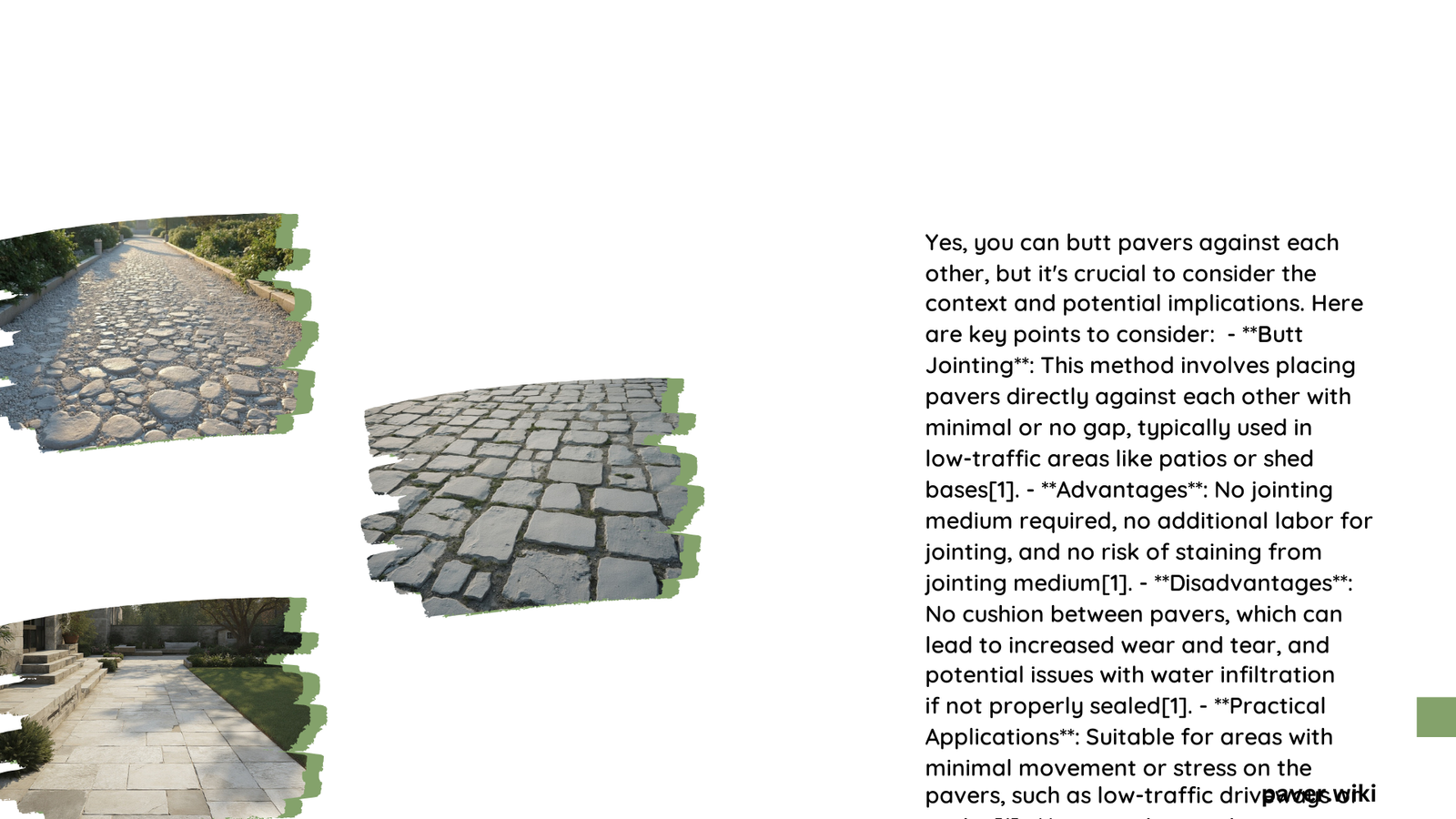When installing pavers, the question of whether to butt them against each other is common. While it’s possible to place pavers close together, it’s not recommended to butt them directly against each other. Proper spacing between pavers is crucial for stability, drainage, and aesthetics. This guide will explore the best practices for paver installation, including optimal joint spacing, installation techniques, and the importance of edge restraints.
What is the Optimal Joint Spacing for Pavers?
The ideal joint spacing for pavers typically ranges from 1/16 inch to 3/16 inch (2 mm to 5 mm). This small gap allows for:
- Proper drainage
- Slight movement without cracking
- Sand filling for stability
It’s important to maintain consistent spacing throughout the installation. No more than 5% of the joints should exceed ¼ inch (6 mm) to ensure straight bond lines and a professional appearance.
How Do I Achieve Proper Paver Spacing During Installation?

To achieve proper spacing when laying pavers:
- Use spacer lugs if available on the pavers
- Employ plastic spacers between pavers
- Utilize a string line for straight rows
- Adjust pavers with a rubber mallet and pry bar
Remember, pavers should be close but not touching. This allows for the specified joint spacing while maintaining a tight, cohesive look.
Why is Joint Sand Important in Paver Installation?
Joint sand plays a crucial role in paver installation:
- Fills gaps between pavers
- Provides stability to the entire surface
- Prevents weed growth
- Allows for slight movement without damage
Use fine-grained sand, such as sifted play sand or specialized paver sand. Ensure both the sand and paver area are dry before filling joints.
What is the Process for Applying Joint Sand?
Follow these steps to properly apply joint sand:
- Spread sand over the paver surface
- Use a broom to sweep sand into joints
- Employ a plate compactor for at least 4 passes
- Add more sand as needed and repeat compaction
- Sweep off excess sand after final compaction
This process ensures that joints are fully filled and compacted, providing maximum stability to the paver installation.
How Do Edge Restraints Affect Paver Installation?
Edge restraints are essential in paver installation for several reasons:
- Prevent lateral movement of pavers
- Maintain the integrity of the paver pattern
- Ensure long-term stability of the installation
Common materials for edge restraints include:
- Plastic
- Concrete
- Aluminum
- Steel
- Pre-cast concrete
- Cut stone
What is the Proper Method for Installing Edge Restraints?
To install edge restraints correctly:
- Place the restraint on the compacted aggregate base
- Position it directly against the outer pavers
- Secure with 3/8\” x 8\” or 10\” steel spikes
- Ensure the restraint can withstand typical forces in residential or light commercial applications
Proper installation of edge restraints is crucial for the longevity and stability of your paver project.
What Are the Benefits of Tight Paver Joints?
Tight paver joints offer several advantages:
- Reduced weed growth
- Enhanced stability
- Improved load distribution
- Aesthetically pleasing appearance
- Easier maintenance
By minimizing the space between pavers, you create a more durable and attractive surface that requires less upkeep over time.
What Challenges Might I Face During Paver Installation?
Common challenges in paver installation include:
- Base preparation
- Maintaining consistent joint spacing
- Proper compaction
- Ensuring level surface
- Dealing with slopes or uneven terrain
Base Preparation
- Use 3/4\” minus modified crushed stone
- Compact to a minimum of 95% Modified Proctor Density
- Ensure base is level and properly graded for drainage
Compaction
- Avoid heavy equipment on newly laid pavers
- Use a low-amplitude plate compactor for initial settling
- Perform multiple passes to ensure proper compaction
What Are the Cost Estimates for Paver Installation?
Paver installation costs can vary widely based on materials and labor. Here’s a general breakdown:
| Component | Cost Range (per square foot) |
|---|---|
| Pavers | $3 – $15 |
| Base Material | $1 – $3 |
| Edge Restraints | $0.50 – $2 (per linear foot) |
| Labor | $2 – $10 |
Factors affecting cost include:
– Type and quality of pavers
– Complexity of design
– Site preparation requirements
– Local labor rates
How Do I Calculate Material Needs for Paver Installation?
To calculate material needs:
- Measure the area to be paved
- Determine base depth based on usage (4\”-6\” for pedestrian, 6\”-12\” for vehicles)
- Add 1\” for sand bedding
- Include paver thickness (typically 2\”-3\”)
Example calculation for a 100 sq ft area with 2.5\” thick pavers:
– Base: 6\” (light vehicle use)
– Sand: 1\”
– Pavers: 2.5\”
– Total depth: 9.5\”
This information helps in ordering the correct amount of materials and planning for excavation depth.
By following these guidelines and best practices, you can create a beautiful and durable paver installation that will last for years to come. Remember, while it may be tempting to butt pavers directly against each other, maintaining proper joint spacing is crucial for the longevity and performance of your paver project.
